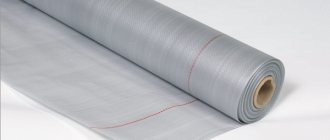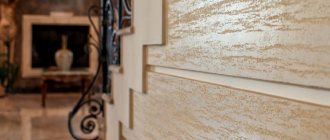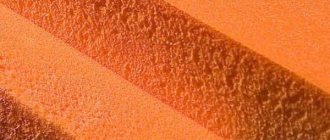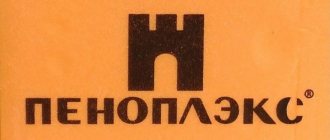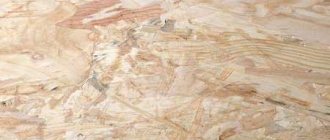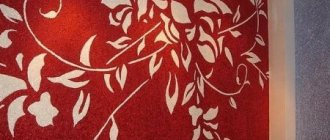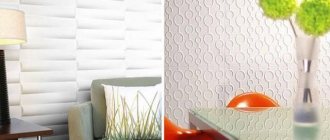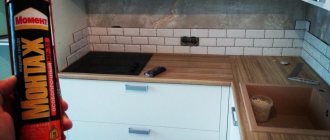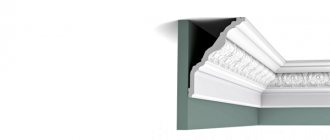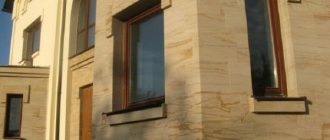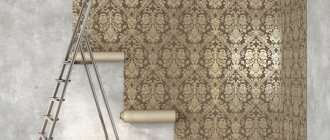What is better for gluing foam?
To obtain a high-quality result when gluing foam plastic to walls, it is recommended to use the following materials:
- compositions based on dry mixtures;
- PVA construction adhesive;
- "liquid nails";
- polyurethane foam;
- polyurethane foam.
Interesting materials:
Why can't you pour cold water on the stones in the bathhouse? Why can't you pump water out of the basement? Why can't you put water into the cooling system? Why is there no hot water pressure in the tap? Why is there no water pressure in the tap? Why is there no water in the toilet tank? Why doesn't my new dishwasher fill with water? Why doesn't the new boiler heat the water? Why is water purified? Why does water remain in the washing machine tray?
Purpose of penoplex
“Penoplex” is a trademark, the boards themselves are extruded polystyrene foam, therefore in many instructions and other documents penoplex is labeled as EPS.
Before examining the types of glue and material installation techniques, let's briefly find out what extruded polystyrene foam (EPS) is, in our case Penoplex.
The material was born in the 30s of the last century in America. At that time, the US military-industrial complex announced a competition to create a lightweight, non-absorbent material for life jackets at sea.
The already known and widely used expanded polystyrene (foam plastic) was taken as a basis, but these slabs easily broke and crumbled into small balls. Then the developers used the extrusion method, which made it possible to make the slab monolithic and increase the strength characteristics by an order of magnitude.
Now there are universal models of insulation from Penoplex that can be mounted on different surfaces
If you do not take into account the dimensions, then visually all Penoplex slabs are the same, however, this insulation is divided into several specialized areas. The topic of the characteristics of each direction is quite extensive and deserves a separate publication, so now we will only outline the priorities.
- To insulate the foundation and basement sector, material labeled “Foundation” is produced. It is able to withstand the load when compacting the earth without deformation, plus it resists frost heaving processes well;
- Wall foam is considered the most popular. It is not designed for strong compression, but the price of this material is lower;
- Penoplayex marked “Roofing” is intended for laying into a roofing pie. The thermal insulation characteristics here are the same as those of the wall version, but the roofing version does not deform at relatively high temperatures, which is important when installing metal tiles and flat roofs in high-rise buildings;
- There is also a material marked “45”, it is intended for highly loaded surfaces. Simply put, it can be safely laid under a reinforced concrete screed when building a garage or house on a slab foundation.
Of all the types of insulation from the Penoplex brand, brand No. 45 is considered the most durable and reliable; these slabs can even be laid under roads and airfield pavements, but the price of the material is high
All boards from Penoplex are absolutely impervious to moisture and can be safely classified as a waterproofing coating. But on the other hand, this is the weak point of this insulation, so when arranging the roof or interior work, it is necessary to take care of additional ventilation, otherwise condensation will accumulate.
When choosing insulation, you need to start not from the price, but from the performance characteristics of a particular Penoplex model.
Soil thermal insulation technology
Thermal insulation of the soil significantly reduces the estimated depth of the foundation, and therefore reduces the overall costs of its construction. It is produced by insulating the blind area.
Insulation of the blind area
Thermal insulation of soil is most often carried out after vertical thermal insulation of the foundation. To do this, near the lower edge of the slabs, backfill with sand or gravel is done 15-20 cm below the ground level. Next, plank formwork about 30 cm high is placed at a distance of a meter from the walls.
The bottom of the blind area is carefully compacted and leveled, and foam tiles are laid on it along the perimeter of the base. A polyethylene film is laid over the penoplex and concrete is poured.
So, insulating the foundation with penoplex prevents freezing of the foundation, does not allow temperature changes and, consequently, the formation of condensation. After the penoplex insulation procedure, which you can easily do yourself, the microclimate in the house improves significantly, which increases the service life of the entire structure.
How to glue correctly?
The process of fixing penoplex boards is not complicated, but requires compliance with special rules and recommendations. First you need to decide on the choice of suitable adhesive regarding the type of wall surface.
Inconsistency between materials threatens to quickly “lag” behind each other and, as a result, additional repair work. The universal building material can be attached to almost any surface, but most often it is concrete, wood and metal.
Fixation to concrete wall
To attach insulation boards to a concrete wall, it is advisable to use a mineral mixture , because the components are almost identical. Initially, the wall must be treated with a primer solution in order to remove dust deposits and other contaminants.
A layer of mortar is applied to the glued side of the slab and evenly distributed using a spatula-comb. Next, she leans against the wall and presses herself.
Combining two slabs together
The two surfaces are cleaned of possible dust formation and treated with a primer. There are no special requirements for the choice of glue, because any is suitable for this procedure.
The technique for applying it can be different, but most often the point method is used. To do this, for example, you need to attach a can of polyurethane glue to a professional construction gun and make short, dotted strokes along the entire perimeter of the slab, as well as a few in the middle.
Foundation made of permanent formwork made of polystyrene foam
For this type of foundation, special insulation in the form of hollow blocks, which are used as formwork for foundation structures. Reinforcement is installed inside the permanent formwork and the foundation is concreted. Waterproofing is carried out on the outside of the formwork.
Such insulation is used when it is necessary to build a house in a short time or when it is necessary to build a foundation with minimal effort.
Advantages of insulation:
- Simple installation system.
- Does not allow the foundation concrete to freeze.
- Allows you to carry out work very quickly.
Minuses:
- High cost of insulation.
- It is necessary to use special vibrators to distribute the concrete mixture inside the formwork.
- There is a high probability that there will be voids in the structure that are not filled with concrete.
- The need to arrange external waterproofing.
Types of adhesives
In order for the choice of adhesive to be made correctly, you need to know exactly what material the foam sheets are glued to. The wrong choice and poor quality of the adhesive cause the destruction of the entire insulating structure.
Polyurethane
Polyurethane adhesive for attaching insulation is convenient even for beginners, since it is available in aerosol form. The product is economical, does not require stirring, and is ready for use immediately after purchase.
- Insta stick. Release form: 0.75 l cylinders. 1 b is spent. for 12-15 m². Coupling time – 20 min. Tensile strength – up to 400 thousand PA. It may freeze. Cannot be used at sub-zero temperatures.
- Titan Stiro-753. Consumption – 1 b. for 14 m². Tensile strength – 600 thousand Pa. Coupling time – 15 min.
- Foamed Fix&Go Montage. This is a frost-resistant composition and can be used at temperatures from -65 to +130 °C.
Polyurethane adhesives can be used to fix penoplex to wood, brick walls, concrete, and to glue slabs together.
Polymer adhesives
Glue for polymer-type penoplex is sold in small cans. The use is justified when slabs need to be glued to metal. The funds are absorbed instantly. It will not be possible to correct the incorrect position of the elements of the insulating structure, so beginners rarely use polymer mixtures.
- Moment. A moisture-resistant, heat-resistant composition, which is sold in containers ranging from 250 ml to 1 liter. A small package is enough to cover 4-5 square meters. surfaces.
- Emfikol 225. Has the same characteristics as “Moment”. It is better to use it outside, since after interior work you need to ventilate the room for 2-3 days.
Mineral
The mineral mixtures are based on cement, ordinary and fine-grained gypsum. Sold in bulk form, need to be kneaded before use. Due to the rapid hardening, the glue must be made in small portions, which are used immediately.
Cement-based mixtures are suitable for external thermal insulation, and gypsum composition is ideal for internal work.
The mixture sets in 1.5-4 hours, which gives a lot of time to change the position of the sheets and eliminate any defects.
Mineral mixtures can only be glued to a pre-primed base. Without primer treatment, the connection will be weak. For high-quality preparation of a single-textured mixture, a construction mixer is used.
- Ceresit CT 83. You can glue the material to any base. Pull strength – 500 kPa, frost-resistant.
- Atlas Stopter K-20. Tensile strength – 600 thousand Pa. Pot life time: 4 hours. Consumption: 4.4 kg per m². The composition is supplemented with reinforcing fiber.
Packed in bags of 5-25 kg.
- If the package is marked F50, it means the product is for indoor use.
- Frost resistance class F100 requires the use of adhesive for exterior use.
Waterproofing compounds
The group includes bitumen, acrylic and rubber compounds. Sold in the form of mastics.
Liquid glue cannot be used, as it will corrode the penoplex, like other petroleum-based waterproofing mixtures.
The best bitumen composition is “Bitumast XPS”. There are no solvents in it, the setting time is 48 hours, the tensile strength is 500 thousand Pa.
Resistant to low temperatures, has improved waterproofing characteristics. Acrylic waterproofing compounds are used to glue slabs to metal, wood, concrete, and brick bases. You can connect two sheets of insulation together and glue it with penofol. The mixtures have low consumption and are suitable for internal and external insulation.
Bitumen mastic
Can work at low temperatures. The insulation is glued onto the bitumen mastic entirely or the joints between individual sheets are filled with it. In the second case, it works as a hydrophobic filler.
To apply mastic, use a spatula or spatula. The product does not require shrinkage. Penoplex can be glued well to a metal or mineral base.
Liquid Nails
Liquid nails can be used to attach penoplex to almost any substrate. If insulation is done inside the house, then standard mixtures are used; heat-resistant liquid nails are selected for external treatment.
The composition is sold in tubes. It should be applied to the sheets in a snake pattern over the entire area for maximum adhesion to the base. Dries in 10-20 seconds. It differs from other products in its rather high price.
The most popular are liquid nails Moment Montazh.
Mixture consumption
The consumption of what can be used to glue penoplex to metal, concrete, brick, wood and other materials depends on the type of base. This indicator is also influenced by the selected composition. So the mixtures are consumed at approximately 3.5-5.5 kg/sq.m. surfaces, foam types are more economical, one cylinder is enough to treat 8-10 sq.m. The manufacturer always prescribes the average consumption of his product. Also on the company’s website you can find an online calculator for calculating the required amount of product for the selected area.
The manufacturer always prescribes the average consumption of his product.
Protective covering
Scheme for attaching penoplex to a brick or concrete wall
In order for the surface of the insulation to look beautiful and be durable, it must be protected. The simplest and cheapest way to protect insulation is plastering, which is carried out in stages.
- Selection of plaster mortar.
- Selection of reinforcing mesh for plaster mortar.
- Fastening the reinforcing mesh using a certain technology.
- Laying the mortar, leveling the surface, grouting with a plastic float.
- Primer the surface for the finishing coat.
- Finish plaster. After drying, painting is done or a transparent protective layer is applied.
Video instruction:
In general, attaching penoplex to concrete and brick walls, as well as insulating the foundation of a building, is not difficult. It is enough to follow the installation technology and carry out the work carefully to ensure that the insulation is attractive and durable.
Subscribe
Installation Tips
Installing penoplex is not a tricky matter, since there are different types of adhesive composition, and accordingly they are applied in different ways. It is better to apply mineral glue with a notched trowel with a comb height of 5 - 10 mm.
The polymers are applied in a random pattern, with a continuous strip drawn along the perimeter with a gap from the edge of 10 - 20 mm. There is also a mop method, which is used for unloaded surfaces.
The choice of method for applying glue to foam boards depends on the degree of surface congestion and the type of composition
Before gluing the penoplex to the walls, a starting support strip is mounted below. For facade work and foundation insulation, a metal profile with an anti-corrosion coating is used. In interior spaces, any support is attached to the wall, for example, a wooden block or lathing.
When producing facade insulation, the starting strip must be made of stainless steel or have an anti-corrosion coating
Important! When working with any glue, before installing the foam board, the base must be covered with primer and dried.
Preparatory work
Regardless of which method of attaching penoplex is chosen, to improve adhesion and extend the service life, the surface should be carefully prepared. Before gluing EPS, you must:
- level the surface;
- clean the concrete surface;
- plaster the wall being treated;
- apply a primer mixture (this treatment will not only increase the adhesion of surfaces, but will also prevent the occurrence of fungi and mold).
If metal rods protruding from the concrete structure interfere with the fastening of the penoplex, it is necessary to level them using a grinder equipped with special diamond wheels for reinforced concrete.
Blind area
To construct a blind area along the foundation, we dig a shallow trench 30-35 cm deep and 70-100 cm wide. If backfilling was performed, then simply leave 30-35 cm at the top to the ground level of the uncovered foundation, and then the trench is expanded to the required size.
At the bottom of the prepared trench, with careful tamping, we arrange a “cushion” of 10-15 cm of sand or sand-gravel mixture. Rolled waterproofing material is laid over the “cushion”, with the joints carefully connected. After this, there can be two options: reinforced concrete is poured over the waterproofing and a blind area is installed, or foam plastic is first laid, and then the blind area is laid over it. The second option, although more expensive, provides additional thermal insulation of the foundation, especially in the case where the underground part was not insulated.
Installation of insulated blind area
For strength, the blind area is reinforced with longitudinal and transverse reinforcement with a diameter of 8-10 mm or a metal mesh with a cross-section of 4-6 mm. To drain water, its surface is inclined, with a slight slope away from the house.
Stamps
Purchasing glue for polystyrene is not a common procedure for those who only carry out repairs in their home or apartment. Therefore, it is better not to waste time (and money) trying to choose the most effective option, but to immediately choose from the highest-rated ones.
Tytan
A universal adhesive, also suitable for improving the exterior, because it is resistant to precipitation and does not allow heat to pass through. It is most rational to purchase the Professional Styro 753 subtype, which provides maximum adhesion of the insulation to the surface.
Ceresit
This product comes in two versions: foam and bulk. The first can be used to insulate the ceiling. The foam hardens quickly and can withstand a wide temperature range - from -10°C to +40°C. And the prepared solution well answers the question “how to glue penoplex to concrete?”, however, two hours should pass between mixing and use.
Moment
The most practical option among those presented, which is even used to create a reinforced mesh, but, as a result, the most expensive. It does not require shrinkage and is also characterized by good elasticity.
Master termol
Due to its high frost resistance, it is purchased for winter work. Recommended for working with limestone materials - reinforced concrete or plaster.
Profline 3k 45
This copy is suitable for those for whom the construction process is a meditative activity that requires prudence and not haste; due to the elasticity and low rate of hardening and setting, the worker will always have the opportunity to check the quality and effectiveness of his work.
Insulation of the building facade
Insulation of walls with penoplex
The main part of heat loss occurs through external walls. Before you begin insulating the facade, it is necessary to carry out preparatory work, which includes:
- cleaning the wall surface from dust and other contaminants;
- leveling with plaster;
- for better adhesion, notches should be applied to a smooth surface using an ax;
- in addition, it is necessary to apply a layer of primer, for this a concrete contact primer would be a good choice.
Read about how to apply primer to walls in this article.
Maybe,
